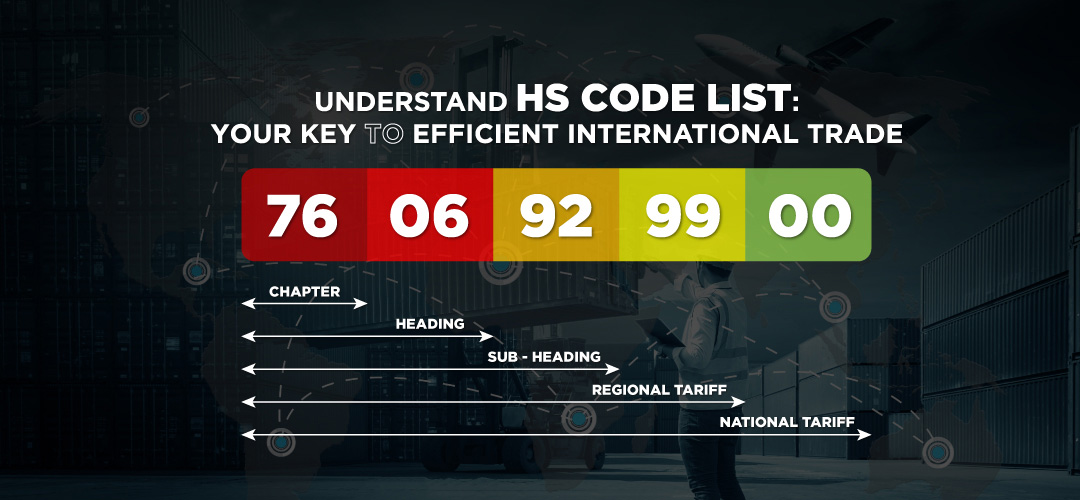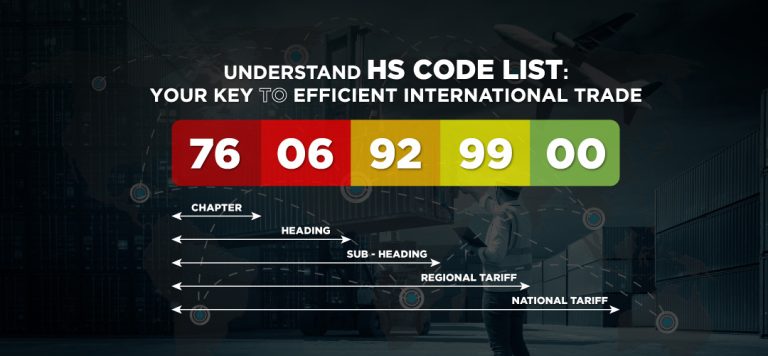In the world of international trade exchange, the HS code list plays a vital role in facilitating the customs clearance process. HS codes, also known as Harmonized System codes, are used to classify goods and determine duties and taxes that apply to imported and exported products.
Having a comprehensive understanding of HS codes is vital to businesses in international trade, as it helps ensure that the correct duties and taxes are paid, reducing the risk of any disputes with customs authorities.
Keep reading to get to know “What is the HS code for customs?” and HS code list.
What is the HS code for customs?
As mentioned earlier, HS codes are used by customs to identify the specific product being imported or exported, including its category, composition, and value.
This information helps to determine the appropriate tariffs and taxes, as well as to track trade patterns and monitor the flow of goods across international borders.
To determine the HS code for a particular product, the product must be classified based on the harmonized system nomenclature.
The HS code system is maintained by the World Customs Organization (WCO) and is updated periodically to reflect changes in the global economy, technology, and trade patterns.
The latest version of the HS includes changes to product classifications, codes, and descriptions to ensure that the system remains relevant and up-to-date.
It is important to note that each country may have several requirements or regulations in addition to the HS code, so it’s necessary for companies to research and comply with all relevant regulations when importing or exporting goods.

Understand HS code list: your key to efficient international trade
By using the HS code system, companies can streamline the customs process, avoid delays and incorrect tariffs, and ensure that their shipments are handled efficiently and effectively.
How to use HS Code List 2022 effectively?
The HS code list is updated regularly to ensure that it remains comprehensive and up-to-date. The latest version of the HS code list is the HS code list 2022, which was published by the World Customs Organization (WCO) in 2022.
The HS code list 2022 includes updates to the classification of various goods, including new products and technologies that have become available since the previous version of the HS code list.
Some of the most common HS Codes for exports to India include:
0306.13 – Frozen shrimp and prawns
0713.33 – Dried leguminous vegetables, shelled
1006.10 – Rice in the husk (paddy or rough)
1207.99 – Other oil seeds and oleaginous fruits
2710.19 – Other petroleum oils and oils obtained from bituminous minerals, crude
7208.51 – Flat-rolled products of iron or non-alloy steel, of a width of 600mm or more, hot-rolled, not clad, plated or coated
8517.12 – Telephone sets, including telephones for cellular networks or for other wireless networks.
In order to use the HS code list 2022 effectively, there is a need for businesses to understand the HS code classification system and the process for determining the correct HS code for a product.
This typically involves reviewing the HS code list and searching for the product in question, taking into consideration its characteristics, such as its composition, use, or method of production.
Why is the HS Code important for customs?
The HS Code plays a critical role in the customs process. It can help customs officials determine the proper duties and taxes that need to be applied to goods being imported or exported.
By having a standardized system for classifying goods, customs officials are able to more accurately determine the value of the goods and the taxes that should be applied.
This helps to ensure that all goods are taxed fairly and consistently, and helps to reduce the potential for misunderstandings or disputes between businesses and customs officials.
Another reason the HS Code is important is that it helps to ensure that goods are properly accounted for and tracked as they are shipped across international borders.
By having a standardized system for classifying goods, customs officials are able to more easily track the movement of goods. It ensures that they are being properly monitored and regulated.
This helps to reduce the potential for smuggling or illegal trade, and helps to ensure that goods are being traded fairly and ethically.
The HS Code is also used by businesses to help them properly label and package their goods for shipment.
By understanding the HS Code that applies to their goods, businesses can ensure that they are labeling and packaging their goods in a way that meets international standards and regulations.
This helps to reduce the potential for delays or complications during the customs process, and helps to ensure that goods are able to be shipped quickly and efficiently.
In general, the HS Code is a perfect tool for customs officials, businesses, and international trade. By providing a standardized system for classifying goods, the HS Code helps to ensure that goods are taxed fairly, tracked and regulated properly, and shipped quickly and efficiently.
Businesses, importers and exporters should take the time to understand the importance of the HS Code and how it applies in their operations.
About DNBC Financial Group
DNBC Financial Group is an outstanding financial institution that specializes in a wide range of financial services, including online payment processing for personal and business purposes.
The company is committed to providing its customers with innovative solutions that meet their remittance for payment needs.
With a focus on delivering high-quality, efficient services, DNBC Financial Group is well positioned to meet the evolving needs of its customers in the rapidly changing financial services industry.
Or please contact DNBC
![]() Email: [email protected]
Email: [email protected]
![]() Phone Number:
Phone Number:
- +65 6572 8885 (Office)
- +1 604 227 7007 (Hotline Canada)
- +65 8442 3474 (WhatsApp)



 DNBC Team
DNBC Team